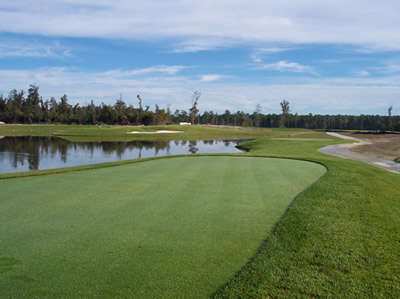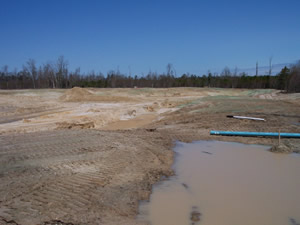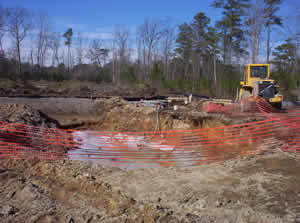 |
| The Peninsula golf course |
(Oct. 17, 2005, St. Paul, Minn.) The Peninsula golf course, located in the Indian River Bay golf community, is a majestic creation neighboring the Atlantic Ocean. Building this ultimate course presented many critical challenges for the course developer, Larry A. Goldstein. This site and the whims of Mother Nature challenged the planning and construction team in numerous ways.
Located just two hours from Washington, D.C., The Peninsula is surrounded by water on three sides in Rehoboth Beach, DE. In addition to demanding natural beauty and luxury, creators of The Peninsula also stressed that the course and the community be operated in an environmentally sensitive manner.
Knowing that nothing brings luxury to a community like water features, The Peninsula was designed to have water visible from almost everywhere, beginning with the first hole where players see a large pond to the left of the tee. The planners designed 20 ponds on the grounds – 10 ponds on the golf course and 10 ponds within the community. The ponds range in size from 302,000 square feet to 11,000 square feet. Developers quickly learned that the site needed work in order to accommodate the multiple water features.
 |
| A very wet "canvas" on which to work |
First, the site had a high ground water table. Some ground water tables were as high as six feet from the ground surface. The ponds needed to be built between 10-12 feet deep. Adding to the high water table problem was an unusual amount of rain during development. Marcus Reams, Project Superintendent for Weitz Golf at The Peninsula, commented that the weather was "uncharacteristically rainy – slowing the speed of construction and keeping the ground water tables high during a time they traditionally drop."
Second, the vision for the finished golf course required complex plantings around the perimeter of the ponds. In order to accommodate these intricate plantings, The Peninsula hired a landscape architect to design the plantings for the littoral shelves. The littoral shelves were integral to providing a place for plants to be established. Each shelf on the finished project (after placement of the soil over burden) was up to two feet deep and 10 feet wide around the perimeter of each of the ponds. Steps and pools on the littoral shelves also were necessary to accommodate the root structure of the placed plants.
 |
| Irrigation lake liner |
Designers specified the use of a liner system in order to achieve the water feature design. Originally the designers recommended that clay liners be used, but clay was not available near the site and the cost of hauling clay to the site was prohibitive. The designers then chose to use a 20-mil PVC geomembrane to line the ponds.
 |
| Dewatering the ponds |
Dewatering the pond basins was a non-stop challenge that was necessary for liner installation. Despite the constant vigilance in this arena, the subgrade could not be made dry and firm over the entire area of the pond. The PVC geomembranes, supplied by Watersaver Company, Inc., Denver, Colo., are pre-fabricated into large panels that can be placed over less than optimal subgrade. Their ability to conform to variances in the subgrade without jeopardizing the integrity of the lining system is one of their characteristics that made PVC ideal in this golf course application. The installed liner was covered with 12-18 inches of soil cover.
The choice in 20-mil PVC geomembrane as the liner system proved fortuitous due to the large amount of rain Delaware received in the summer of 2004. The high ground water table in conjunction with record rainfall meant that dewatering the ponds was a constant and unforgiving process. The large 20-mil PVC panels covered the graded dirt area very quickly and provided cover for the subgrade, minimizing the negative impact of the rain.
In this project, the ponds were being placed below the natural ground water level in many cases. Because of this, it was paramount that the liner stayed in place and didn’t rise under the pressure of ground water. The use of burp valves booted to the bottom of the liner resolved this issue by allowing air and water to escape from under the liner. A burp valve is a PVC pipe with a check valve that releases groundwater into the pond when pressure builds up from the groundwater.
Additionally, as the golf course was constructed, designers made some dramatic changes to the size and shape of the ponds. The use of PVC panels allowed flexibility in design changes as the project was built.
PVC also was a crucial liner selection as the construction team required versatility in welding options. PVC can be welded using both wedge welding and chemical fusion. There were parts of the job that could not be welded using a wedge welder because the subgrade conditions were too difficult to successfully run a wedge welder. In these cases chemical fusion welding was the only option.
Despite the numerous challenges The Peninsula team faced, the final decision to use 20-mil PVC geomembrane combined with their talent and hard work helped them surmount and accomplish the building of a beautiful golf community. Scheduled to be completed in early summer of 2005, The Peninsula, with its abundant water features, promises to deliver an ultimate golfing experience.
For more information about using PVC geomembranes, visit the PVC Geomembrane Institute’s (PGI) website at www.pvcgeomembrane.com. The 1104 PGI Specification is listed on the website to assist designers in specifying and selecting PVC geomembranes. Information is also available by contacting the office of PGI at +1-217-333-3929.
Jorge Huerta, Weitz Golf International, was the Construction Project Manager for The Peninsula on the Indian River Bay.
Marcus Reams, Weitz Golf International, was the Construction Superintendent for The Peninsula on the Indian River Bay.











